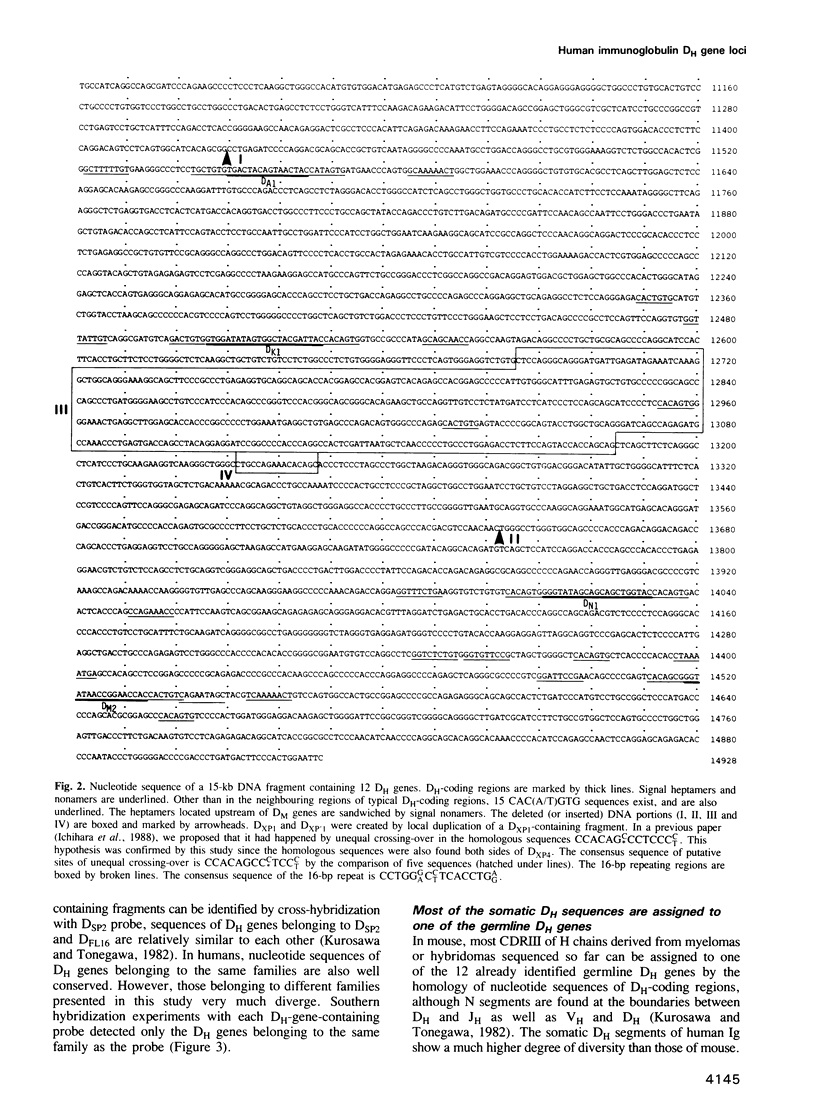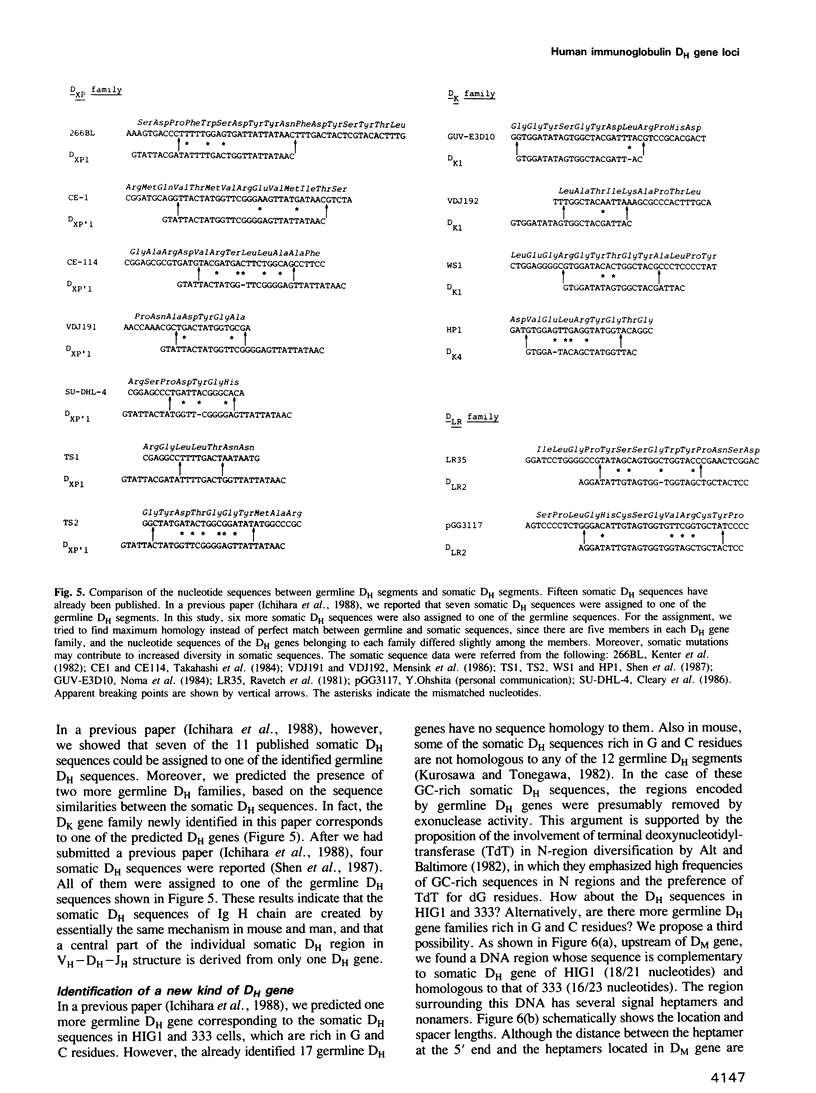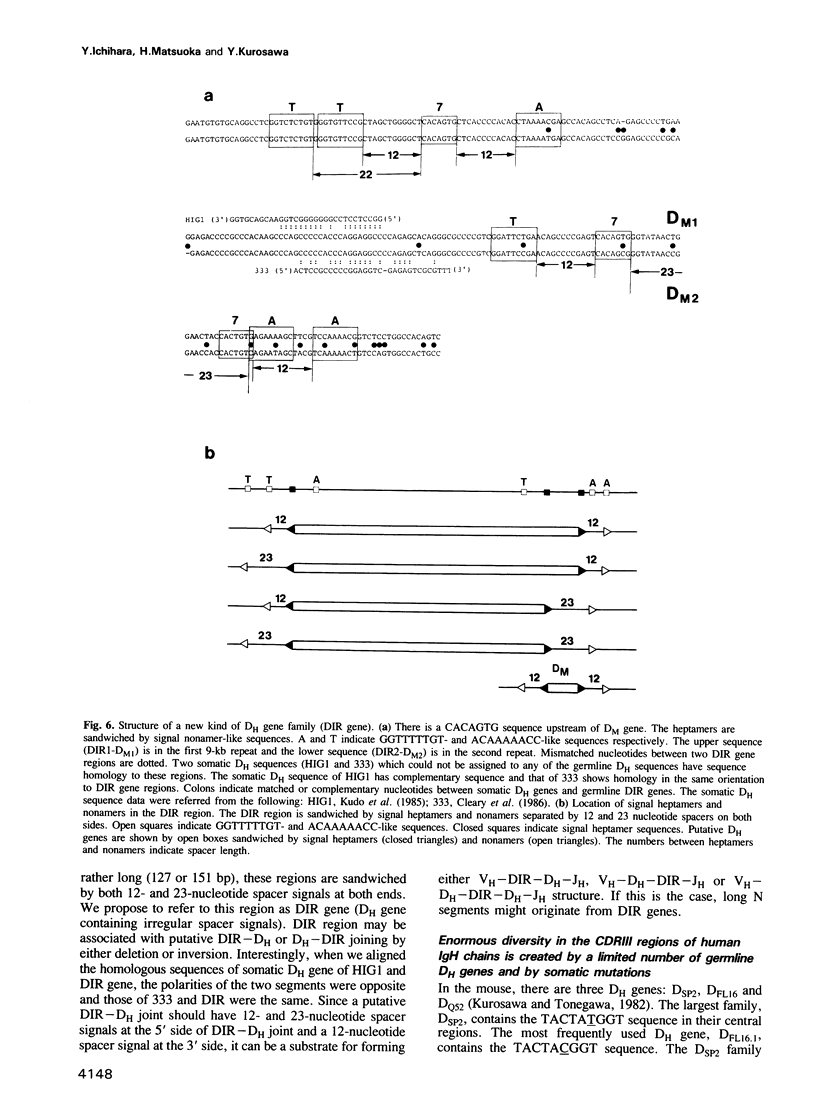Abstract
The variable region of immunoglobulin heavy chain is encoded by three separate genes on the germline genome: variable (VH), diversity (DH) and joining (JH) genes. Most human DH genes are encoded in 9-kb repeating sequences. We determined the nucleotide sequence of a 15-kb DNA fragment containing more than one and a half of these repeating units, and identified 12 different DH genes. Based on the sequence similarities of DH coding and the surrounding regions, they can be classified into six different DH gene families (DXP, DA, DK, DN, DM and DLR). Nucleotide sequences of DH genes belonging to different families diverge greatly, while those belonging to the same families are well conserved. Since the 9-kb DNA containing the six DH genes are multiplied at least five times, the total number of DH genes must be approximately 30. These DH genes are sandwiched by 12-nucleotide spacer signals. Most of the somatic DH sequences found in the published VH-DH-JH structures (the somatic DH segment being defined as the region which is not encoded either by germline VH or JH gene) were assigned to one of the germline DH genes. Other than these typical DH genes, however, we found a new kind of DH gene (which we termed DIR) the spacer lengths of whose neighbouring signals were irregular. The DIR gene appears to be involved in DIR-DH or DH-DIR joining by inversion or deletion. Two of the somatic DH sequences were assigned to the DIR genes. Long N segments might, therefore, originate from DIR genes.
Full text
PDF









Images in this article
Selected References
These references are in PubMed. This may not be the complete list of references from this article.
- Akira S., Okazaki K., Sakano H. Two pairs of recombination signals are sufficient to cause immunoglobulin V-(D)-J joining. Science. 1987 Nov 20;238(4830):1134–1138. doi: 10.1126/science.3120312. [DOI] [PubMed] [Google Scholar]
- Alt F. W., Baltimore D. Joining of immunoglobulin heavy chain gene segments: implications from a chromosome with evidence of three D-JH fusions. Proc Natl Acad Sci U S A. 1982 Jul;79(13):4118–4122. doi: 10.1073/pnas.79.13.4118. [DOI] [PMC free article] [PubMed] [Google Scholar]
- Alt F. W., Yancopoulos G. D., Blackwell T. K., Wood C., Thomas E., Boss M., Coffman R., Rosenberg N., Tonegawa S., Baltimore D. Ordered rearrangement of immunoglobulin heavy chain variable region segments. EMBO J. 1984 Jun;3(6):1209–1219. doi: 10.1002/j.1460-2075.1984.tb01955.x. [DOI] [PMC free article] [PubMed] [Google Scholar]
- Buluwela L., Albertson D. G., Sherrington P., Rabbitts P. H., Spurr N., Rabbitts T. H. The use of chromosomal translocations to study human immunoglobulin gene organization: mapping DH segments within 35 kb of the C mu gene and identification of a new DH locus. EMBO J. 1988 Jul;7(7):2003–2010. doi: 10.1002/j.1460-2075.1988.tb03039.x. [DOI] [PMC free article] [PubMed] [Google Scholar]
- Cleary M. L., Smith S. D., Sklar J. Cloning and structural analysis of cDNAs for bcl-2 and a hybrid bcl-2/immunoglobulin transcript resulting from the t(14;18) translocation. Cell. 1986 Oct 10;47(1):19–28. doi: 10.1016/0092-8674(86)90362-4. [DOI] [PubMed] [Google Scholar]
- Early P., Huang H., Davis M., Calame K., Hood L. An immunoglobulin heavy chain variable region gene is generated from three segments of DNA: VH, D and JH. Cell. 1980 Apr;19(4):981–992. doi: 10.1016/0092-8674(80)90089-6. [DOI] [PubMed] [Google Scholar]
- Feinberg A. P., Vogelstein B. A technique for radiolabeling DNA restriction endonuclease fragments to high specific activity. Anal Biochem. 1983 Jul 1;132(1):6–13. doi: 10.1016/0003-2697(83)90418-9. [DOI] [PubMed] [Google Scholar]
- Gross-Bellard M., Oudet P., Chambon P. Isolation of high-molecular-weight DNA from mammalian cells. Eur J Biochem. 1973 Jul 2;36(1):32–38. doi: 10.1111/j.1432-1033.1973.tb02881.x. [DOI] [PubMed] [Google Scholar]
- Henikoff S. Unidirectional digestion with exonuclease III creates targeted breakpoints for DNA sequencing. Gene. 1984 Jun;28(3):351–359. doi: 10.1016/0378-1119(84)90153-7. [DOI] [PubMed] [Google Scholar]
- Ichihara Y., Abe M., Yasui H., Matsuoka H., Kurosawa Y. At least five DH genes of human immunoglobulin heavy chains are encoded in 9-kilobase DNA fragments. Eur J Immunol. 1988 Apr;18(4):649–652. doi: 10.1002/eji.1830180426. [DOI] [PubMed] [Google Scholar]
- Kenten J. H., Molgaard H. V., Houghton M., Derbyshire R. B., Viney J., Bell L. O., Gould H. J. Cloning and sequence determination of the gene for the human immunoglobulin epsilon chain expressed in a myeloma cell line. Proc Natl Acad Sci U S A. 1982 Nov;79(21):6661–6665. doi: 10.1073/pnas.79.21.6661. [DOI] [PMC free article] [PubMed] [Google Scholar]
- Kudo A., Ishihara T., Nishimura Y., Watanabe T. A cloned human immunoglobulin heavy chain gene with a novel direct-repeat sequence in 5' flanking region. Gene. 1985;33(2):181–189. doi: 10.1016/0378-1119(85)90092-7. [DOI] [PubMed] [Google Scholar]
- Kurosawa Y., Tonegawa S. Organization, structure, and assembly of immunoglobulin heavy chain diversity DNA segments. J Exp Med. 1982 Jan 1;155(1):201–218. doi: 10.1084/jem.155.1.201. [DOI] [PMC free article] [PubMed] [Google Scholar]
- Matsuda F., Lee K. H., Nakai S., Sato T., Kodaira M., Zong S. Q., Ohno H., Fukuhara S., Honjo T. Dispersed localization of D segments in the human immunoglobulin heavy-chain locus. EMBO J. 1988 Apr;7(4):1047–1051. doi: 10.1002/j.1460-2075.1988.tb02912.x. [DOI] [PMC free article] [PubMed] [Google Scholar]
- Mensink E. J., Schuurman R. K., Schot J. D., Thompson A., Alt F. W. Immunoglobulin heavy chain gene rearrangements in X-linked agammaglobulinemia. Eur J Immunol. 1986 Aug;16(8):963–967. doi: 10.1002/eji.1830160815. [DOI] [PubMed] [Google Scholar]
- Mizusawa S., Nishimura S., Seela F. Improvement of the dideoxy chain termination method of DNA sequencing by use of deoxy-7-deazaguanosine triphosphate in place of dGTP. Nucleic Acids Res. 1986 Feb 11;14(3):1319–1324. doi: 10.1093/nar/14.3.1319. [DOI] [PMC free article] [PubMed] [Google Scholar]
- Noma Y., Yaoita Y., Matsunami N., Rosén A., Klein G., Honjo T. Immunoglobulin gene organization of ultraviolet-illuminated human lymphoblastoid cell lines producing both IgM and IgG. Mol Biol Med. 1984 Oct;2(5):337–350. [PubMed] [Google Scholar]
- Olszewska E., Jones K. Vacuum blotting enhances nucleic acid transfer. Trends Genet. 1988 Apr;4(4):92–94. doi: 10.1016/0168-9525(88)90095-9. [DOI] [PubMed] [Google Scholar]
- Ravetch J. V., Siebenlist U., Korsmeyer S., Waldmann T., Leder P. Structure of the human immunoglobulin mu locus: characterization of embryonic and rearranged J and D genes. Cell. 1981 Dec;27(3 Pt 2):583–591. doi: 10.1016/0092-8674(81)90400-1. [DOI] [PubMed] [Google Scholar]
- Sakano H., Hüppi K., Heinrich G., Tonegawa S. Sequences at the somatic recombination sites of immunoglobulin light-chain genes. Nature. 1979 Jul 26;280(5720):288–294. doi: 10.1038/280288a0. [DOI] [PubMed] [Google Scholar]
- Sakano H., Kurosawa Y., Weigert M., Tonegawa S. Identification and nucleotide sequence of a diversity DNA segment (D) of immunoglobulin heavy-chain genes. Nature. 1981 Apr 16;290(5807):562–565. doi: 10.1038/290562a0. [DOI] [PubMed] [Google Scholar]
- Sanger F., Nicklen S., Coulson A. R. DNA sequencing with chain-terminating inhibitors. Proc Natl Acad Sci U S A. 1977 Dec;74(12):5463–5467. doi: 10.1073/pnas.74.12.5463. [DOI] [PMC free article] [PubMed] [Google Scholar]
- Schilling J., Clevinger B., Davie J. M., Hood L. Amino acid sequence of homogeneous antibodies to dextran and DNA rearrangements in heavy chain V-region gene segments. Nature. 1980 Jan 3;283(5742):35–40. doi: 10.1038/283035a0. [DOI] [PubMed] [Google Scholar]
- Shen A., Humphries C., Tucker P., Blattner F. Human heavy-chain variable region gene family nonrandomly rearranged in familial chronic lymphocytic leukemia. Proc Natl Acad Sci U S A. 1987 Dec;84(23):8563–8567. doi: 10.1073/pnas.84.23.8563. [DOI] [PMC free article] [PubMed] [Google Scholar]
- Siebenlist U., Ravetch J. V., Korsmeyer S., Waldmann T., Leder P. Human immunoglobulin D segments encoded in tandem multigenic families. Nature. 1981 Dec 17;294(5842):631–635. doi: 10.1038/294631a0. [DOI] [PubMed] [Google Scholar]
- Southern E. M. Detection of specific sequences among DNA fragments separated by gel electrophoresis. J Mol Biol. 1975 Nov 5;98(3):503–517. doi: 10.1016/s0022-2836(75)80083-0. [DOI] [PubMed] [Google Scholar]
- Takahashi N., Noma T., Honjo T. Rearranged immunoglobulin heavy chain variable region (VH) pseudogene that deletes the second complementarity-determining region. Proc Natl Acad Sci U S A. 1984 Aug;81(16):5194–5198. doi: 10.1073/pnas.81.16.5194. [DOI] [PMC free article] [PubMed] [Google Scholar]
- Tonegawa S. Somatic generation of antibody diversity. Nature. 1983 Apr 14;302(5909):575–581. doi: 10.1038/302575a0. [DOI] [PubMed] [Google Scholar]
- Yanisch-Perron C., Vieira J., Messing J. Improved M13 phage cloning vectors and host strains: nucleotide sequences of the M13mp18 and pUC19 vectors. Gene. 1985;33(1):103–119. doi: 10.1016/0378-1119(85)90120-9. [DOI] [PubMed] [Google Scholar]
- Zong S. Q., Nakai S., Matsuda F., Lee K. H., Honjo T. Human immunoglobulin D segments: isolation of a new D segment and polymorphic deletion of the D1 segment. Immunol Lett. 1988 Apr;17(4):329–333. doi: 10.1016/0165-2478(88)90006-5. [DOI] [PubMed] [Google Scholar]





